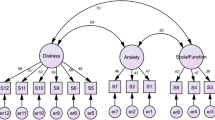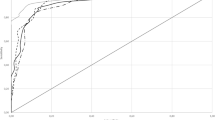Abstract
Objective
We hypothesised that, in a non–Western setting where literacy was not universal, a visual measure (the FACES test) would be more valid than a traditional psychiatric questionnaire [the General Health Questionnaire (GHQ)] as a screening test for mood disorders.
Methods
The study was nested within a randomised controlled trial of 450 patients with a common mental disorder (CMD). Subjects were evaluated at 2, 6 and 12 months after enrolment with the Clinical Interview Standardised-Revised (CISR) (the gold standard), the GHQ5 (the shortened version of the GHQ-12) and the FACES test.
Results
Correlation coefficients and Receiver Operating Characteristic (ROC) curves show superiority of the GHQ5 in the detection of CMD based on the CISR, compared with the visual FACES test. Lesseducated subjects had particular difficulty completing the FACES. The kappa coefficient of agreement between the two instruments, using the cut–off point for the GHQ5 estimated by the ROC curves, was between 0.70 and 0.75.
Conclusions
Contrary to our hypothesis, the questionnaire–based measure was significantly superior to a visual measure of mood, especially for less–educated subjects. A short five–item version of the GHQ has a good discriminatory ability for CMD and may be used as a brief alternative to standardised interviews in clinical and survey settings.
Similar content being viewed by others
References
Bosi Ferraz M, Tugwell P, Goldsmith CH, Atra E (1990) Metanalysis of sulfasalazine in ankylosing spondilitis. J Rheumatol 17:1482–1486
Darwin C (1998) The expression of emotions in man and animals, 3 edn, Harper Collins, Glasgow
Ekman P (1982) Emotions in the human face, 2 edn, Cambridge University Press, Cambridge
Goldberg D, Oldehinkel T, Ormel J (1998) Why GHQ threshold varies from one place to another. Psychol Med 28:915–921
Goldberg D, Williams P (1988) A User’s Guide to the General Health Questionnaire NFER-Nelson, Windsor
Gosselin P, Larocque C (2000) Facial morphology and children’s categorisation of facial expression of emotions: a comparison between Asian and Caucasian faces. J Gen Psychol 161:346–358
Hale WW, Jansen J, Bouhuys A, Van den Hoofdakker R (1997) The judgement of facial expressions by depressed patients, their partners and controls. J Affect Disord 4:56–65
Kirkwood B, Sterne J (2003) Essential Medical Statistics (2nd edition). Blackwell Science. Oxford
Kirmayer LJ (1989) Cultural variations in the response to psychiatric disorders and emotional distress. Soc Sci Med 29:327–339
Leach E (1972) “The influence of cultural context on nonverbal communications in man,” in Nonverbal Communication, R Hinde, ed., Cambridge University Press, Cambridge, pp 315–347
Lewis G, Pelosi A, Araya R, Dunn G (1992) Measuring psychiatric disorder in the community: a standardized assessment for use by lay interviewers. Psychol Med 22:465–486
McKelvie SJ (1995) Emotional expression in upside-down faces: evidence for configurational and componential processing. Br J Soc Psychol 34:325–334
Patel V (2001) Cultural factors and international epidemiology. Br Med Bull 57:33–46
Patel V, Chisholm D, Rabe-Hesketh S, Dias-Saxena F, Andrew G, Mann A (2003) The efficacy and cost-effectiveness of a drug and psychological treatment for common mental disorders in general health care in Goa, India: a randomised controlled trial. Lancet 361:33–39
Patel V, Pereira J, Mann A (1998) Somatic and Psychological Models of Common Mental Disorders in India. Psychol Med 28:135–143
Ridout N, Astell A, Reid I, Glen T, O’Carrol RE (2003) Memory bias for emotional facial expressions in major depression. Cognition & Emotion 17:101–122
Author information
Authors and Affiliations
Corresponding author
Rights and permissions
About this article
Cite this article
Puertas, G., Patel, V. & Marshall, T. Are visual measures of mood superior to questionnaire measures in non–Western settings?. Soc Psychiatry Psychiatr Epidemiol 39, 662–666 (2004). https://doi.org/10.1007/s00127-004-0800-2
Accepted:
Issue Date:
DOI: https://doi.org/10.1007/s00127-004-0800-2




